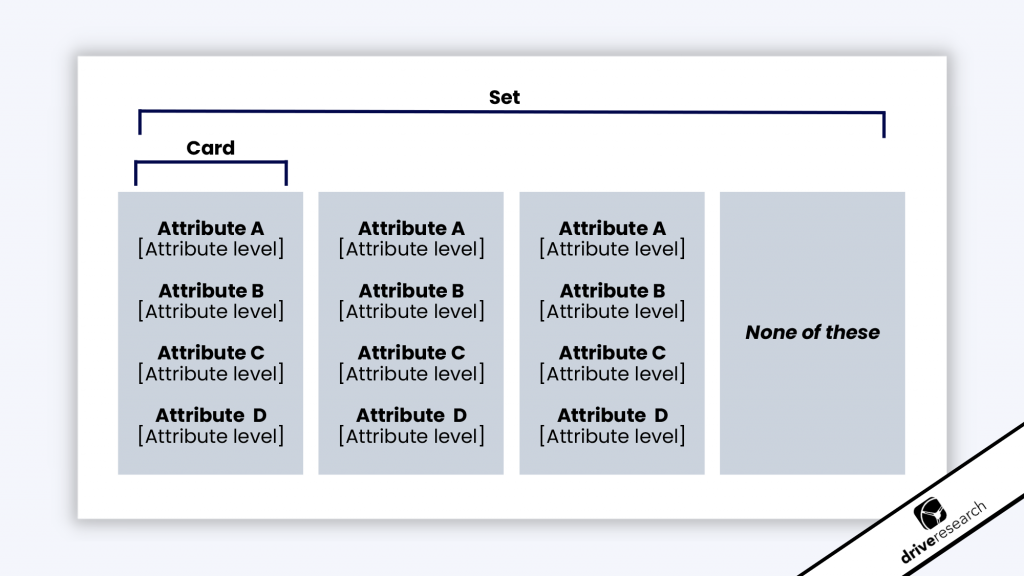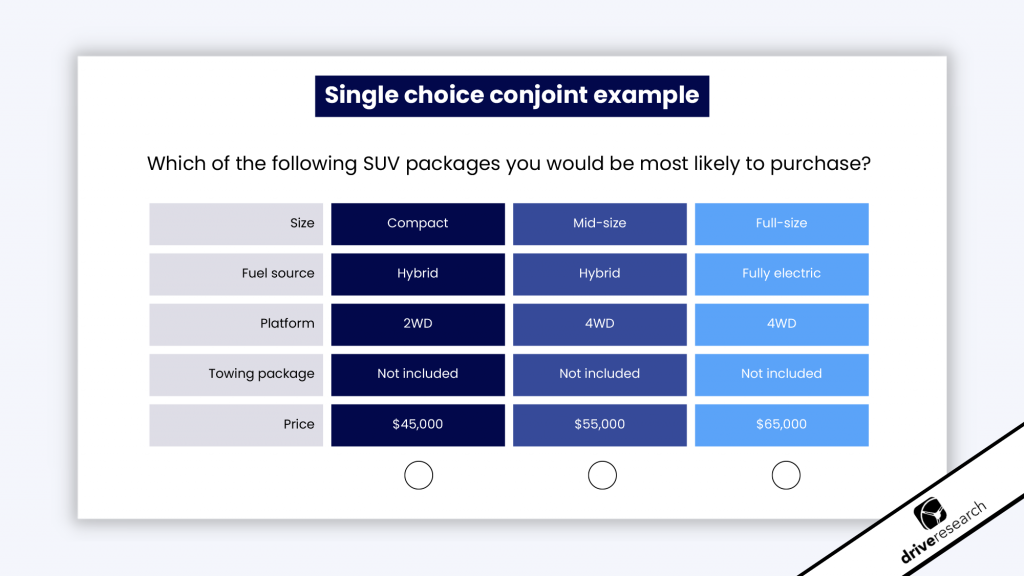
If you have ever considered market research that asks respondents to make trade-off decisions, there is a good chance you have heard of MaxDiff or conjoint research.
These are two powerful and advanced research techniques that go a step beyond direct question-and-answer analysis.
Both of these research methods have one thing in common: they each allow businesses to understand which features directly impact their target audience.
However, these techniques have distinct applications that should be considered before tossing them into your next online survey.
To help explain, below I will cover what MaxDiff and conjoint are, practical examples, how they differ, and best uses of each.
What Is MaxDiff?
MaxDiff is an advanced survey data collection method that researchers use to prioritize a list of attributes, features, statements, or other items.
It is a repetitive exercise in which respondents are presented with a handful of items to review which are placed into two groups:
- The one they deem the “best”
- The one they deem the “worst”
There is flexibility in the terms used for the two selections as long as they are opposites.
Respondents may repeat this exercise anywhere from 1 to 30 times depending on the total number of items in the list. Ideally, you want respondents to see each item at least three times over the course of the MaxDiff exercises.
The resulting data consists of how often each item was selected as “best”, selected as “worst”, or not selected when displayed. An analysis creates a hierarchy of the items factoring in all the data.
The items at the top can be interpreted as the best overall. Conversely, the items that fall to the bottom would be the worst overall.
One of the key benefits of MaxDiff is how it challenges respondents to consider each set of items they are presented with. The trade-offs with each decision help increase differentiation in the results versus the risk of respondents selecting everything as important in “Select all that apply” or Likert scale-style questions.
Example of MaxDiff Analysis
Let’s take a look at an example of how MaxDiff works. Say a company wants to determine which features of a new smartphone are most valued by potential customers.
They design a survey where respondents select the most and least important features from selections such as:
- Price
- Battery life
- Camera quality
- Screen size
- Overall style
After collecting responses, they analyze the data to produce a utility score for each feature.
Results might show that price is the most important feature (22%) and the operating system the least important (2%), helping the company prioritize features in their product development.
What Is Conjoint Analysis?
Conjoint analysis is an advanced survey research method that focuses on product or service optimization.
This technique presents survey respondents with hypothetical products or services and asks them to choose which one they prefer. Each product or service is defined by multiple predetermined attributes with various levels under each attribute.

These questions replicate real-world decision-making, collecting valuable data with every respondent selection. The data is used to calculate utility values (desirability measurements) for each attribute level featured in the design. The relative importance of each attribute overall can also be calculated.
The results of a conjoint analysis can be inserted into a market simulator to see the impact of a customized portfolio of products and services.
Using a market simulator allows a business to estimate the market share of its current offerings, potential new offerings, and competitive offerings in any combination.
Example of Conjoint Analysis
Here is an example of how conjoint analysis can be helpful. Let’s say a car manufacturer wants to understand consumer preferences for a new model.
They conduct a conjoint analysis by presenting potential buyers with different car configurations, varying attributes such as engine type (hybrid, gasoline), price ($35,000, $45,000, $65,000), and additional features (size, platform, towing package).
Then, respondents rank or choose their preferred options among these combinations in a survey. The analysis reveals that consumers value advanced safety features the most, followed by engine type and then price.

With this insight, the company can focus on incorporating advanced safety features into their new model and highlight these features in marketing campaigns to better meet consumer demands and maximize market share.
Check out some additional examples of conjoint analysis here.
MaxDiff vs. Conjoint Analysis – What’s The Difference?
Even though we have covered the basics of MaxDiff and conjoint analysis, you may still be wondering what makes each technique unique. While they both utilize trade-offs in respondent decision-making, these two methods are not interchangeable.
Their primary objectives and outputs are what set them apart.
While you can determine the importance of product attributes using either one, conjoint analysis allows you to test different levels of each attribute at one time.
MaxDiff only gives respondents individual items to choose from, not built-out products made up of several attributes.
When to Use MaxDiff vs. Conjoint Analysis
Below are some of the most common applications for MaxDiff and conjoint analysis. These use cases help illustrate how these two techniques differ and where they each might fit within your business objectives.
When to Use MaxDiff
- Feature Prioritization: If you have a list of product or service features but don’t know what customers most value, consider using MaxDiff. The results will provide a clear order of importance for all the features.
- Message Testing: MaxDiff may also be leveraged to test advertising copy, taglines, or positioning statements. You will be able to narrow down which messaging performs the best among your target audience.
- Segmentation: If your ultimate goal is to segment your customers or market, MaxDiff offers an excellent first step. By having respondents select the psychographics they most and least identify with, you have a reliable method for collecting the input data for a segmentation cluster analysis.
When to Use Conjoint Analysis
- New Product Development: Conjoint can be a great tool for businesses that are looking to launch a new product or service. You may learn the best combination of attribute levels to maximize market share and avoid cannibalization.
- Portfolio Consolidation: Conjoint also works well if your goal is to optimize your current portfolio of products and services. See the direct impact of consolidating or removing offerings to be as efficient as possible.
- Competitive Assessment: If your competition plays an important role in the market, consider using a conjoint analysis to gauge how their latest move affects your business. Simulating market share for your products against competitive brands will allow you to make strategic decisions based on reliable data
Contact Our Market Research Analysis Company
Both MaxDiff and conjoint analysis are incredibly useful in understanding what features matter most to consumers. Using this data, brands can continuously improve their offerings and drive business.
Our team is well-versed in both MaxDiff and conjoint analysis, and can help guide brands to choose which method is best based on their unique needs.
Interested in learning more about our market research services? Reach out to us today.



